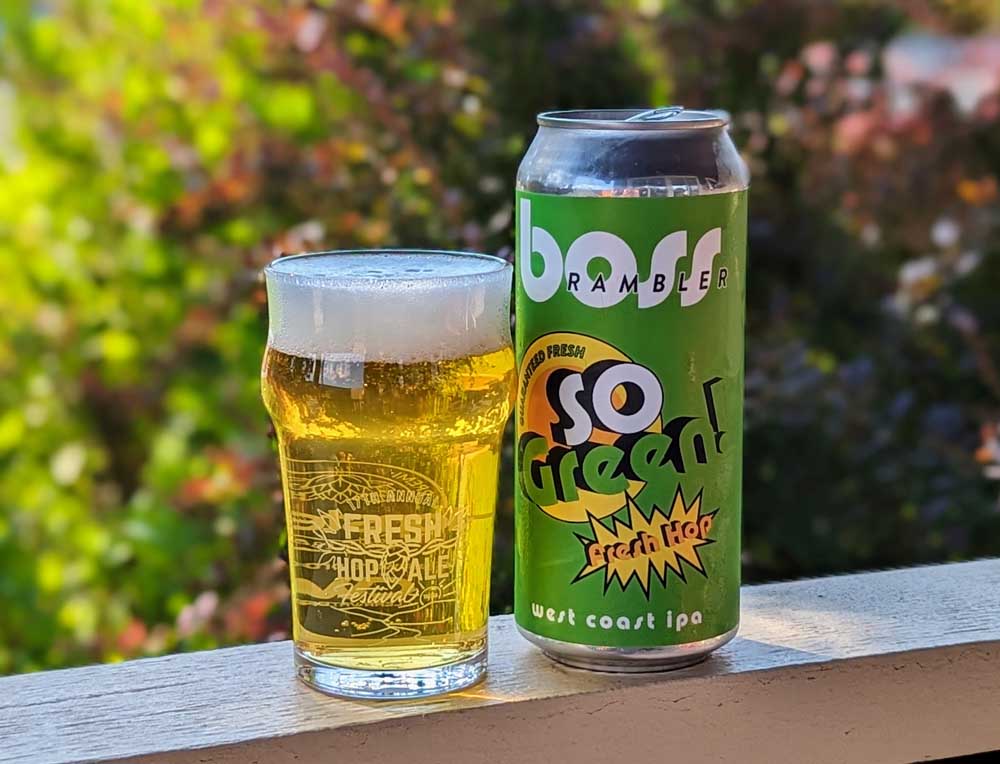Boss Rambler Beer Club’s three fresh-hop beers
Published 11:45 am Wednesday, September 6, 2023

- Boss Rambler infused So Green, one of its three fresh-hop beers, with Centennial hops that went through a liquid nitrogen freezing process.
I’ve written quite a bit on fresh-hop beers in this space over the years, detailing various varieties of hops, the brewing process and even the number of them brewed.
Most breweries employ similar techniques in producing these harvest ales, in which freshly picked hops are added at various stages of brewing, which infuse the beer with qualities that can only be captured during this time of year.
Boss Rambler Beer Club was among the first to market this year and recently released three fresh-hop beers in cans that were crafted with an unusual approach — the fresh hops were flash frozen with liquid nitrogen, and then shattered before being added to the beer.
It’s a technique pioneered by Portland’s Breakside Brewery, which first attempted it in 2014. Breakside has since refined it in the years since, but the core process remains the same.
It directly exposes the lupulin glands to the liquid, the parts of the hop containing the oils, resins and acids, in theory allowing the freshest essence of the hop to permeate the brew.
Other breweries have adopted this freezing method, including Migration Brewing Co. of Portland and Sunriver Brewing Co., which has brewed its Fresh Hop Holy Schmidt Festbier with frozen Liberty hops.
For Boss Rambler, freezing the hops is also about timing.
“One of the main reasons we use this process is to get the finished beer out as quickly after the hops were picked as possible (versus brewing with them and waiting the 3+ weeks to finish),” said founder Matt Molletta via email. “Additionally, using the hops on the cold side (versus hot) give off different flavor notes which is unique and fun to explore.”
The brewery’s three fresh-hop beers are So Green, a West Coast IPA; So Fresh, a hazy IPA; and So Clean, an American-style lager.
So Green is the first of three to roll off the canning line from the brewery. Boss Rambler infused it with fresh Centennial hops that went through the liquid nitrogen freezing process; according to Molletta, 3 pounds of fresh hops were used per barrel. “We dry-hopped this particular beer for three days on the fresh hops,” he said.
I picked up a can to try it out; it’s 6.9% alcohol by volume, and pours a bright golden color into the glass. I found it pungent with a prominent fresh-cut green grass character in the aroma, with a big herbal note that prompted me to write “hop pesto” in my notebook — a description I’ve never used before.
The flavor likewise features a grassy-herbal hop punch, a touch vegetal with a burst of chlorophyll, intense enough to be piney and even minty with a fresh menthol-like character. It’s not unlike chewing on a fresh hop flower, and it lingers into the finish in such a way that feels light and minty-fresh.
I was able to try the other two beers, canned only a few days prior. So Fresh was brewed with fresh Strata and Luminosa hops, and So Clean was brewed with fresh Strata as well.
So Clean exhibited lush aromas of strawberry and dank herbs, and while I found the flavor a bit more restrained as a lager, it did have spicy tobacco-like notes and hints of Thai basil and matcha. In So Fresh, a hazy IPA, I found it fragrant with citrusy orange and floral tropical fruit which was reflected in the flavor.
All three cans are available now, and Molletta teased several other draft-only fresh-hop beers coming up.
“We’ll be using fresh Simcoe in both a West Coast and Hazy IPA, as well as some Citra and Mosaic hops later in the picking season. Folks can stay tuned to our Instagram page for all the latest,” he said.
Falling Putt IPA — Bevel Craft Brewing
Reverie Pils — Monkless Belgian Ales
Hold the Pickle — Fort George Brewery
Guava Hibiscus Hard Cider — Bend Cider Co.
Silver Tip IRA — Grand Fir Brewing






